Table of Contents
- 1. Why does my welding rod sticking to metal
- 2. Preventing Welding Rod Sticking
- 3. Reasons Behind Welding Rod Sticking
- 4. Resolving Stuck Welding Rods
- 5. Choosing the Right Welding Rod
- 6. Identifying and Diagnosing Sticking
- 7. Effective Practices to Avoid Rod Sticking
- 8. Conclusion and Final Thoughts
- Conclusion
- FAQs
In welding, the frustration of a rod stubbornly sticking to the metal is a common hurdle. Understanding why this happens and how to prevent it can significantly elevate your welding game. Delving into the reasons, solutions, and proactive measures, this article offers a clear roadmap to conquer this persistent issue and ensure smoother, more efficient welding experiences.
1. Why does my welding rod sticking to metal
Welding rod sticking to the base metal occurs due to several key factors. Understanding these reasons is pivotal to effectively addressing the issue.
- Low Amperage Settings: When the welding machine operates at insufficient amperage, the rod can stick as it fails to generate the necessary heat for a smooth arc.
- Inadequate Arc Length: A short arc length can cause the rod to stick. Maintaining an appropriate distance between the rod and the work surface is crucial for a consistent, non-sticking arc.
- Poor Surface Conditions: Dirty or contaminated metal surfaces hinder smooth welding. Impurities like dirt, rust, or mill scale can lead to the rod adhering to the metal.
- Incorrect Electrode Selection: Using an incompatible or incorrect electrode for the base metal can result in sticking issues. Ensuring the right electrode for the job is essential.
- Material Thickness and Heat: Thick materials or those with inadequate preheating may cause the welding rod to stick due to inconsistent heat distribution across the surface.
- Flux Quality: Low-quality or damaged flux on the electrode can contribute to sticking problems. High-quality flux ensures smooth arc ignition and stability.
- Electrode Angle and Technique: Incorrect angles or improper welding techniques can cause the rod to stick. Maintaining the right angle and employing proper techniques prevent adherence.
- Pre-Flow and Preheating: Lack of pre-flow of shielding gas or inadequate preheating of the metal can lead to the rod sticking during welding.
Understanding these factors provides a comprehensive overview of why welding rods stick to metal, forming the basis for effective solutions and preventive measures.
2. Preventing Welding Rod Sticking
Addressing the causes of welding rod sticking involves implementing preventive measures and proactive techniques. Here’s a breakdown of effective strategies to avoid this issue:
- Set Proper Amperage: Ensuring the welding machine operates at the right amperage prevents the rod from sticking due to insufficient heat. Follow manufacturer guidelines or adjust based on material thickness.
- Maintain Correct Arc Technique: Employ the appropriate technique for initiating the arc and sustaining a consistent bead. A smooth, steady motion prevents the rod from adhering to the metal.
- Ensure Current Flow in the Welding Circuit: Check for any interruptions or irregularities in the current flow that might cause sticking. A consistent flow ensures a stable welding process.
- Quality Check for Welding Rods: Inspect welding rods for defects, damage, or flux quality issues before use. High-quality rods reduce the likelihood of sticking during welding.
- Verify Rod Tip Condition: Before striking the arc, inspect the rod tip for any contaminants or irregularities. A clean tip promotes a smooth start without sticking.
- Avoid Incompatibilities: Ensure compatibility between the welding machine and the rods being used. Mismatched equipment can lead to sticking issues.
- Preheating the Base Metal: Properly preheating the base metal, especially for thicker materials, reduces the likelihood of rod sticking by ensuring consistent heat distribution.
- Utilize Anti-Stick Features: When available, employ welding machines equipped with anti-stick features or use inverters that help prevent rod adherence to the metal surface.
Implementing these preventive measures significantly minimizes the chances of welding rods sticking to the base metal, allowing for smoother and more efficient welding processes.
3. Reasons Behind Welding Rod Sticking
Understanding the underlying reasons for welding rod adherence to the base metal is pivotal in troubleshooting and rectifying the issue. Let’s explore these contributing factors in depth:
- Surface Conditions: The cleanliness and quality of the metal surface play a crucial role. Contaminants like dirt, rust, or mill scale hinder a smooth welding process, causing the rod to stick.
- Arc Lengths: Maintaining an appropriate distance between the rod and the work surface is vital. Too short an arc length results in the electrode sticking to the metal.
- Amperage Settings: Insufficient amperage fails to generate the necessary heat, leading to poor arc stability and potential rod sticking.
- Material Thickness and Surface Heat: Thick materials or those inadequately preheated pose challenges. Inconsistent heat distribution across the surface can cause rods to stick during welding.
- Poor Welding Techniques: Incorrect angles, erratic movements, or improper welding procedures contribute to rods sticking. Mastering proper techniques reduces this issue significantly.
- Electrode Selection: Using an incompatible or incorrect electrode for the base metal leads to sticking problems. Matching the electrode to the metal type is critical.
- Electrode Angle: Maintaining the correct angle while welding is crucial. Deviating from the optimal angle can cause the rod to stick or lead to poor weld quality.
- Lack of Pre-Flow: Inadequate shielding gas or lack of pre-flow can result in impurities affecting the welding process, causing rods to stick.
Understanding these nuanced factors enables welders to pinpoint potential issues and employ targeted solutions to prevent welding rods from sticking to the base metal during the welding process.
4. Resolving Stuck Welding Rods
Encountering a stuck welding rod during a welding session can be frustrating, but several effective methods can swiftly address this issue:
- Immediate Response:
Stop the welding process as soon as you notice the rod sticking to the metal.
Release the electrode holder’s trigger to halt the arc.
- Increase Amperage or Arc Length:
If the rod sticks due to insufficient heat, adjust the welding machine’s amperage settings to generate more heat.
Increase the arc length slightly to create a better gap between the rod and the work surface.
- Clean the Surface:
Remove any contaminants from the metal surface using a wire brush, grinder, or appropriate cleaning tools.
Ensure the surface is free from rust, dirt, or mill scale that might cause the rod to stick.
- Change Electrode Angle or Technique:
Adjust the angle of the electrode holder to the recommended position.
Modify the welding technique to ensure a smoother, more controlled arc.
- Inspect and replace Rods:
Check the quality and condition of the welding rods being used.
Replace damaged or defective rods with high-quality ones to prevent further sticking issues.
- Preheating or Adjusting Material Heat:
Preheat the base metal adequately, especially for thicker materials.
Ensure uniform heat distribution across the surface to prevent the rod from sticking.
- Use Anti-Stick Features:
If available, activate anti-stick features on the welding machine or use equipment specifically designed to prevent rod adherence.
- Resume Welding Carefully:
After addressing the sticking issue, cautiously restart the welding process to ensure a smooth and uninterrupted arc.
By employing these responsive measures, welders can quickly overcome stuck welding rods and resume a seamless welding operation, minimizing downtime and ensuring better welding outcomes.
5. Choosing the Right Welding Rod
Selecting the appropriate welding rod is crucial to prevent sticking issues and achieve optimal welding results. Here’s a comprehensive guide to aid in the selection process:
- Understanding Electrode Classifications:
Different electrodes are designed for specific welding tasks and materials.
Electrodes are classified based on their composition, coating, and intended applications.
- Consider metal type and thickness:
Match the electrode to the type of metal being welded (steel, aluminum, stainless steel, etc.).
Consider the thickness of the metal, as it influences the choice of electrode size and type.
- Electrode Coating and Flux:
Electrodes are coated with flux to protect the weld pool and improve arc stability.
Flux composition varies, providing different properties like self-shielding or requiring external shielding gas.
- Electrode Diameter and Amperage:
The electrode diameter dictates the amperage settings required for optimal performance.
Consult the manufacturer’s guidelines to match the electrode diameter with the appropriate amperage range.
- Special Considerations:
For specific applications or environmental conditions, specialized electrodes might be necessary (low hydrogen, high penetration, etc.).
- Quality Check:
Inspect welding rods for any defects, damage, or inconsistencies in coating or flux.
Choose high-quality rods from reputable manufacturers to ensure reliability and performance.
- Trial and testing:
Conduct trial welds with different electrodes to assess their suitability for the intended application.
Evaluate bead appearance, penetration, and overall weld quality to determine the most suitable electrode.
- Continuous Learning and Adaptation:
Stay updated with advancements in electrode technology and welding techniques to optimize welding processes continually.
By understanding the nuances of electrode selection and considering various factors, welders can make informed choices, mitigating the chances of welding rod sticking and achieving superior welding results.
6. Identifying and Diagnosing Sticking
Recognizing when welding rods stick and understanding the underlying reasons is pivotal for effective troubleshooting. Here’s a detailed breakdown of identifying and diagnosing this issue:
Physical Symptoms:
- Resistance while Welding: If you encounter increased resistance or dragging while welding, it might indicate the rod is sticking.
- Irregular Arc Behavior: Fluctuations in the arc, erratic sparking, or inconsistent weld pool formation are signs of sticking.
Visual Clues:
- Spatter and Irregular Bead Appearance: Excessive spatter or irregular bead formation often accompanies sticking.
- Weld Pool Disturbance: Observing disruptions or disturbances in the weld pool during welding can signal rod adherence.
Sudden Stops or Interruptions:
Abrupt halts in the welding process, particularly when accompanied by the rod sticking to the metal, indicate this issue.
- Arc Interruptions:
If the arc frequently extinguishes or struggles to reignite during welding, it might be due to the rod sticking.
- Heat and Sound:
Unusual hissing or crackling sounds coupled with excessive heat generation at the electrode tip might indicate sticking.
- Inspect the welding environment:
Check for proper shielding gas flow, ground connections, and cleanliness of the work area.
Ensure the electrode, surface, and equipment are free from contaminants that might cause sticking.
- Review welding parameters:
Check the welding machine’s settings, including amperage, voltage, and arc length, to identify discrepancies causing sticking.
- Trial and error:
Experiment with adjustments in technique, electrode angle, or amperage settings to diagnose and rectify the sticking issue.
By being vigilant and observant during the welding process, welders can detect the signs of rod sticking early on and take corrective measures to maintain a smooth and uninterrupted welding operation.
7. Effective Practices to Avoid Rod Sticking
Implementing proactive measures and best practices can significantly reduce the occurrence of welding rod sticking. Here’s a detailed exploration of these effective practices:
- Maintain clean surfaces.
Thoroughly clean and prepare the metal surfaces before welding to eliminate contaminants that may cause the rod to stick.
Use wire brushes, grinders, or appropriate cleaning tools to remove rust, dirt, or mill scale.
- Adopt Correct Starting Techniques:
Employ proper arc-initiation techniques to ensure a smooth start without the electrode sticking to the metal.
Master techniques like scratch starting or using a high-frequency start, depending on the welding process.
- Secure ground connections:
Ensure a strong and stable ground connection between the workpiece, welding machine, and electrode holder to prevent erratic arcs or sticking.
- Maintain Optimal Arc Length and Angle:
Maintain the recommended arc length and electrode angle throughout the welding process to ensure a consistent and stable arc.
- Choose Appropriate Electrodes:
Select electrodes compatible with the base metal and the welding process to minimize sticking issues.
Consider factors like electrode diameter, composition, and flux type for optimal performance.
- Preheating and Pre-Flow:
Preheat the base metal when necessary to ensure uniform heat distribution, reducing the likelihood of rods sticking.
Ensure proper shielding gas pre-flow to protect the weld area from contaminants.
Continuous Monitoring and Adjustment:
Regularly monitor welding parameters such as amperage, voltage, and travel speed to maintain an optimal welding environment.
Adjust settings as needed to prevent sticking and ensure a smooth welding process.
- Post-Weld Cleanup:
After welding, perform post-weld cleanup to remove any slag, spatter, or residual contaminants that might cause sticking in subsequent welds.
By incorporating these effective practices into the welding process, welders can proactively minimize the chances of welding rod sticking, ensuring smoother and more efficient welding operations.
8. Conclusion and Final Thoughts
Addressing the issue of welding rod sticking involves understanding its causes, implementing preventive measures, and employing effective solutions. Here’s a concise summary and concluding thoughts:
- Understanding the Challenge:
Welding rod sticking to the base metal is a common issue caused by factors like improper settings, surface conditions, and electrode selection.
- Preventive Measures:
Setting proper amperage, maintaining correct arc technique, ensuring current flow, and using quality rods are key preventive steps.
- Responsive Solutions:
Immediate actions when rods stick involve adjusting amperage, cleaning surfaces, changing angles, or inspecting and replacing rods.
- Electrode Selection Importance:
Choosing the right electrode based on metal type, thickness, coating, and quality significantly reduces sticking occurrences.
- Identifying Sticking Signs:
Recognizing physical symptoms, visual cues, interruptions in the welding process, and heat or sound irregularities helps diagnose sticking.
- Proactive Practices:
Maintaining clean surfaces, adopting correct techniques, securing ground connections, and continuous monitoring are effective proactive measures.
- Continuous Improvement:
Regularly updating knowledge on welding processes, electrode technology, and techniques ensures ongoing optimization for preventing rod sticking.
Conclusion
Overcoming welding rod sticking involves a combination of proactive measures, responsive solutions, and continuous learning to maintain a smooth and efficient welding experience.
By comprehensively understanding the causes, employing preventive measures, promptly addressing sticking instances, and continuously refining welding practices, welders can navigate the challenge of rod sticking, ensuring consistent and high-quality welds.
FAQs
Does welding rod diameter affect sticking?
Yes, using the correct rod diameter suitable for the welding job reduces the chances of sticking.
Can a wrong electrode cause sticking?
Yes, using an incompatible electrode might lead to sticking issues during welding.
How can I prevent my welding rod from sticking?
Ensure proper amperage, maintain an optimal arc length, and clean the metal surface before welding.
Does preheating the base metal help avoid sticking?
Preheating can reduce the risk of sticking, especially with thicker materials.
Are there welding machines that prevent sticking?
Yes, some machines feature anti-stick capabilities, minimizing rod adherence to metal surfaces.
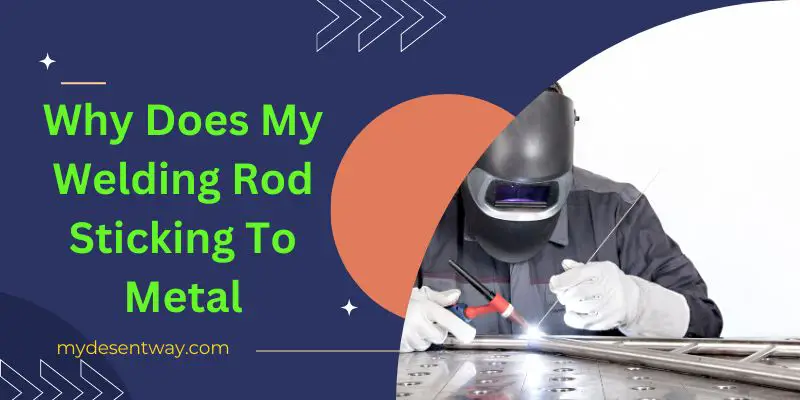

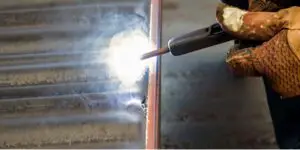
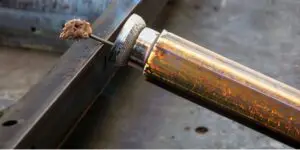
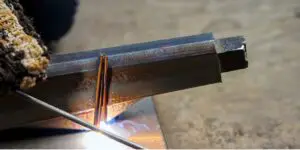

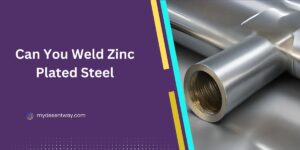

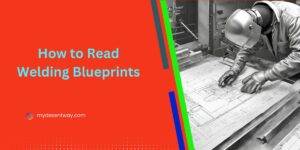




6 thoughts on “Why Does My Welding Rod Sticking to Metal 5 Effective Solutions”